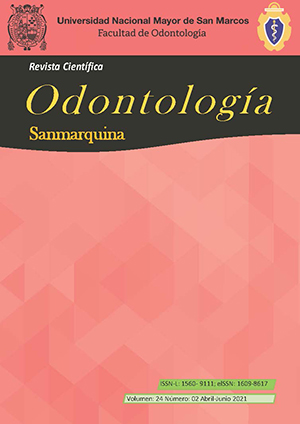Marginal adaptation of lithium disilicate crowns obtained by scanning techniques (CAD/CAM): in vitro confocal microscopy analysis
DOI:
https://doi.org/10.15381/os.v24i2.19895Keywords:
Ceramics, Dental marginal adaptation, Computer aided design, Microscopy confocal, (source: MeSH NLM)Abstract
Objective. This study aimed to evaluate lithium disilicate marginal adaption on crowns by scanning techniques (CAD/CAM), before and after crystallization, through confocal microscopy (CM) in vitro analysis. Methods. Sixteen polyurethane replicas were performed from tooth 1.4, of a typodont model, prepared for a full crown. The replicas were divided into two groups, according to the scanning technique: Indirect Technique (Group IND, n=08), where dental stone models were scanned with a laboratory scanner (inEos X5, Sirona Dental Systems) and Direct Technique (Group DIR, n=08), where typodont models were scanned with an intraoral scanner (CEREC BlueCam, Sirona Dental Systems). Then, the lithium disilicate crowns (IPS e.max CAD, Ivoclar Vivadent) were milled (inLab MC XL, Sirona Dental Systems) and adapted to the replicas. Marginal adaptation was evaluated with CM analysis before and after lithium disilicate crystallization. Data were analyzed with the Mann-Whitney, t test, and Wilconxon test (α=0.05). Results. There was a statistically significant difference in horizontal marginal adaptation between IND and DIR groups after crystallization (p=0.05). In IND group, the comparison of vertical marginal adaptation before and after crystallization showed a statistically significant difference (p=0.038). Conclusions. Lithium disilicate crowns obtained by direct scanning technique (CAD/CAD) showed less vertical marginal maladjustment. The crystallization stage affected the crown’s marginal adaptation.
Downloads
Downloads
Published
Issue
Section
License
Copyright (c) 2021 Bruna Neves de Freitas, Karen Pintado-Palomino, Bruna Santos Honório Tonin, Pedro Bastos Cruvinel, Ana Paula Macedo, Camila Tirapelli, Takami Hirono Hotta, Wilson Matsumoto

This work is licensed under a Creative Commons Attribution 4.0 International License.
AUTHORS RETAIN THEIR RIGHTS:
a. Authors retain their trade mark rights and patent, and also on any process or procedure described in the article.
b. Authors retain their right to share, copy, distribute, perform and publicly communicate their article (eg, to place their article in an institutional repository or publish it in a book), with an acknowledgment of its initial publication in the Odontología Sanmarquina.
c. Authors retain theirs right to make a subsequent publication of their work, to use the article or any part thereof (eg a compilation of his papers, lecture notes, thesis, or a book), always indicating the source of publication (the originator of the work, journal, volume, number and date).




















